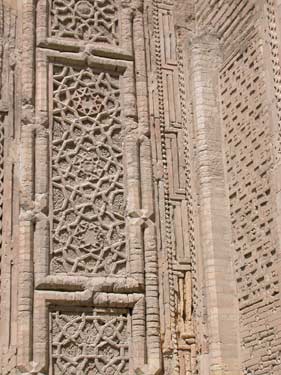|
Category
|
Magoki Attori Mosque
Thus, from historical sources that in place Magoki Attori before Islam was a market where trading idols, medicinal potions and herbs. Such traders are called "Attoron", the word "Magoki" means "the pit, a deep place." There is the Temple of the Moon. Most likely, this temple was a place of worship of "Sin" - God of the Moon. In Mesopotamia, there were two major centers of the cult: Ur in the south and Harran in the north. Rooting worship in Bukhara likely refers to the ancient period, when Babylon and Assyria had a strong influence on the development of this region. Moon was the patron god of nomadic peoples, as the moon lit their way during the night wanderings. Therefore, it is also possible that this cult has been adapted by local nomads with the introduction of some local features. In XVI c. Abdulaziz Khan I undertook major repairs of the mosque, which was completed in 1549 then there is a new eastern (upper) portal, because the ancient southern portal of the was under multimeter layer of cultural deposits. Now the southern façade is fully released and restored.
Another interesting fact in the life of this structure may serve as a fact that before the construction of the first Synagogue in Bukhara Jews prayed in the same room with the Muslims. This premise is Magoki Attori. Today in the building of mosque houses a Museum of carpets. Here are copies of the masters of carpet weaving in Azerbaijan, Turkmenistan, China, Uzbekistan and other countries. This architectural monument is one of the most ancient witnesses to the long history of Bukhara. Until now, scientists have not finished studying it. And the fact that it has been found in the St. Petersburg Hermitage. |
 Magoki Attori is considered the oldest surviving, and perhaps the first mosque in Bukhara. The first building on the site of the mosque was built in the IX century. Abu Bakr Muhammad ibn al-Narshahi, who completed his famous work on the history of Bukhara in 943, at the chapter "The Story of Moh- market" ("moh" - the moon) writes: "In Bukhara was a market, called Moh-bazaar. Two times a year for one day had been there negotiating. Every time in this market ... selling idols in the ancient inhabitants of Bukhara were idolaters, and then entered the trade in idols used in this market, this custom is preserved ... Later this place was the temple of Zoroastrians, on the days designated for bargaining, the people gathered here, all included in the temple and worshiped fire. This temple existed here before the placement of Islam, when Muslims, efforts have built on this spot his mosque, and is now one of the great mosques of Bukhara "
Magoki Attori is considered the oldest surviving, and perhaps the first mosque in Bukhara. The first building on the site of the mosque was built in the IX century. Abu Bakr Muhammad ibn al-Narshahi, who completed his famous work on the history of Bukhara in 943, at the chapter "The Story of Moh- market" ("moh" - the moon) writes: "In Bukhara was a market, called Moh-bazaar. Two times a year for one day had been there negotiating. Every time in this market ... selling idols in the ancient inhabitants of Bukhara were idolaters, and then entered the trade in idols used in this market, this custom is preserved ... Later this place was the temple of Zoroastrians, on the days designated for bargaining, the people gathered here, all included in the temple and worshiped fire. This temple existed here before the placement of Islam, when Muslims, efforts have built on this spot his mosque, and is now one of the great mosques of Bukhara " The mosque is an architectural monument. It refers to a type of cl osed mosques, with the overlap of the six stone pillars. Of particular note is its southern portal - a work of art. The portal and entrance of the niche are decorated with polished masonry bricks, glazed majolica, carved alabaster and terracotta. From inside the east entrance to the very floor of the monument down the broad stone staircase. In addition to its direct purpose, it also serves as a place for prayer.
The mosque is an architectural monument. It refers to a type of cl osed mosques, with the overlap of the six stone pillars. Of particular note is its southern portal - a work of art. The portal and entrance of the niche are decorated with polished masonry bricks, glazed majolica, carved alabaster and terracotta. From inside the east entrance to the very floor of the monument down the broad stone staircase. In addition to its direct purpose, it also serves as a place for prayer.














